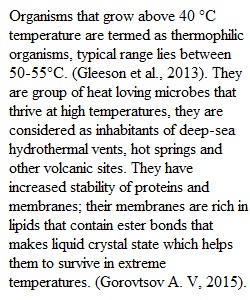


Q REPORT 2 The information below is the same as that from the lab manual. Report 2: Physical factors due: _______________ Purpose statement (2 point) Theory and background (8 points) (Citations should be in the text in APA format) Define the following terms being careful to explain why they impact bacterial growth: to following terms: • Temperature requirements (thermophile, mesophile, psychrophile) Define and describe modifications allowing organisms to grow at these temperatures. • Oxygen requirements (aerobic, anaerobic, obligate anaerobe, facultative anaerobe, microaerophile) Define and relate to organism respiration/fermentation and enzymes required to process oxygen free radicals. Results (4 points) (in paragraph form) • Only include the macroscopic observations, what did you see or measure. (NO CONCLUSIONS) • Graphs of data on temperature ranges. Make sure to label appropriately and give a short title and description under the figure. Conclusions (4 points) (Citations should be in the text in APA format) • From each of your results, what can you determine about the extra microbe you were assigned. Why did it react the way that they did? Make sure to link it back to your biochemical explanations from your introduction on what these conclusions say about how your organism grows and why it grows under those conditions. • How did you come to those conclusions? (tell me what lead you to that thought) • Where there any results that might have been wrong? Why? • Connect these ideas back to the theory and background section about what your conclusions mean and what that means about the organism. The last two points of the report are for formatting and readability: • 1) correct formatting, grammar and spelling, particularly with scientific names or microbiology vocabulary (Did you italicize or underline bacterial names) • 2) appropriate font style and size (10-12), less than 1 inch margins, appropriate indenting and at least two outside sources (other than the resources listed as required in the syllabus). APA format in both the text and references listed at the end of the paper. Expectations With Reports Expectations With Reports 1. Make sure you know how to properly cite and quote your sources. Manchester Community College takes plagiarism very seriously and if encountered will result in a zero- whether intentional or unintentional. Please visit http://owl.english.purdue.edu/owl/resource/560/01/ or use the MCC library resources if you have questions or doubts about plagiarism. The use of APA or scientific citing formats is acceptable. 1. Facts (dates, numbers and individual people) should be cited in parentheses just after the fact or at the end of the sentence. 2. Pictures also need to be cited directly next to or below the picture. 3. When taking information directly from another author without rewording their ideas (copying more than six words in a row), quotation marks must be used at the beginning of the section and at the end of the section taken. A citation should then be used at the end of the quotation marks. This includes information from the course resources. 4. When trying to reword another author’s work, taking their wording and using a thesaurus to change a few words does not count as rewording, and still requires citation. If you are struggling to reword, it is preferable to simply quote another author to changing only one or two words. 5. Plagiarism, intentional or otherwise, will result in a zero. Negligence is not an excuse for misrepresenting another’s work as your own. 2. Reword as much of the information as you can. You should use no more than three quotes in a single paper. Anyone can parrot back what someone said, rewording the information shows understanding and comprehension of why it is important. 3. General references (including those cited and quoted) for all sections must be listed at the end of the paper in alphabetical order, by author. Make sure to also include the article name, journal or book name, date of publication, and (if available) the website address. 4. Grading in the background section and the conclusions section is based on how in depth your explanations were for everything you needed to cover. 5. Do not “name drop.” Mentioning a microbial specific vocabulary word, does not show understanding and comprehension. Take the time to explain what it means, why it is important or how it works. 6. Understand how scientific or binomial nomenclature works in the writing of scientific papers. Make sure all bacterial names are underlined or italicized and written with capitalized first letter of first name and lower case all for the second. 7. Grammar and spelling do count. If you need help with this, the Academic Success Center (ASC) is able to provide assistance.
View Related Questions